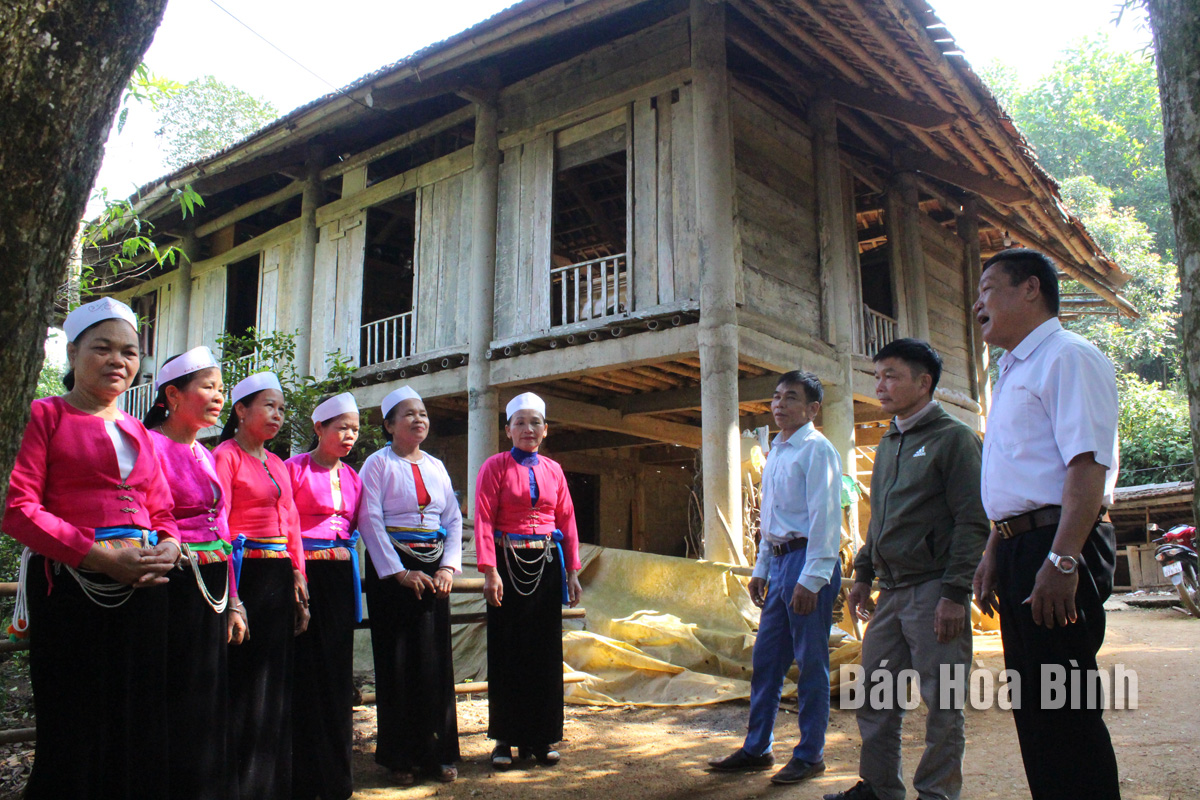
As a land deeply intertwined with human history and Vietnam’s millennia-long journey of nation-building and defence, Hoa Binh is often revered for its epic tales and legends.
Residents of Hoa Binh boast a rich cultural identity, reflected in their unique language, traditional attire, customs, and folk melodies – described as "sweet as honey, clear as a mountain stream.”
Artisans from Vu Binh commune, Lac Son district performe antiphonal singing.
A land of cultural heritage
Home to ethnic groups such as the Muong, Thai, Tay, Dao, and Mong, Hoa Binh boasts a diverse and distinctive cultural identity. The province is renowned for its historical legacy, from the prehistoric Hoa Binh Culture to its vibrant traditional festivals and folk music. The province boasts 786 recognised cultural heritages and around 600 historical relics, including four national intangible cultural heritage treasures – the Muong gong art, Mo Muong folk ritual, traditional knowledge of bamboo calendars, and the Khai ha festival. Additionally, the two sites of Xom Trai Cave and Lang Vanh stone shelter in Lac Son district have been designated as national special relics.
Today, many of the local traditional cultural practices continue to thrive. The Muong people, in particular, maintain a close connection with nature, preserving their unique customs and artistic expressions.
A deep historical legacy
According to historian professor Le Van Lan, the history of Hoa Binh extends far beyond 1886 – the year it was officially recognised as a province under French colonial rule. The region’s past dates back thousands of years to prehistoric times, when early humans inhabited its caves and rock shelters. While the Red River Delta remained submerged under water, Hoa Binh’s valleys emerged as a cultural and economic centre, with the Hoa Binh Culture, flourishing between 18,000 and 7,500 years ago. The province is also the only place in Vietnam where evidence of prehistoric art has been discovered. A notable example is a rock painting in Dong Noi Cave (Dong Tam, Lac Thuy district), depicting a human face and three grazing animal heads, showcasing early artistic expression.
As humans transitioned to agriculture, they gradually moved from caves to settlements along rivers and hillsides, developing tools from stone, bronze, and iron. Excavations in Cho Cave (Cao Son, Luong Son district) uncovered a 4,000-year-old burial site from the Phung Nguyen Culture, while traces of the Dong Son Culture have been found in Lac Thuy, Mai Chau, and Da Bac districts, indicating early settlement by Dong Son people in Hoa Binh.
During the thousand years of Chinese domination, historical records on Hoa Binh remain scarce. As a mountainous region, it remained largely untouched by Han rule and cultural assimilation, preserving its indigenous identity.
During Vietnam’s feudal era, spanning the Dinh, Ly, Tran, Le, and Nguyen dynasties, Hoa Binh’s history remains relatively undocumented. However, while the centralised monarchy ruled over the country, the Muong people maintained their lang dao system, the group’s typical traditional form of governance. Despite its hierarchical nature, the region was engaged in trade, as evidenced by Vietnamese, Chinese, and Japanese ceramics found in burial sites. Archaeological findings also suggest a shared ancestral connection between the Muong and the Kinh (Vietnamese majority), tracing back to the ancient Viet-Muong people.
The Muong people have preserved a vast repertoire of epics, folklore, proverbs, folk songs, and gong music, despite the absence of a written script. These cultural treasures have been passed down through generations, ensuring their survival to the present day.
With a historical depth spanning tens of thousands of years and the flourishing of numerous cultural traditions, Hoa Binh rightfully earns its place as a land of epics and legends, professor Lan affirmed.
With an increasingly vibrant and widespread emulation movement aimed at building cultured residential areas and cultured families, Yen Thuy District has been making steady progress toward improving both the material and spiritual well-being of its people, while fostering a civilized, prosperous, beautiful, and progressive community.
Once lacking recreational spaces and community facilities, Residential Group 2 in Quynh Lam Ward (Hoa Binh City) has recently received attention for the construction of a new, spacious, and fully equipped cultural house. The project followed the model of state support combined with public contributions in both labor and funding.
The "All people unite to build cultural life" movement, which has been effectively integrated with Kim Boi district’s socio-economic development goals, is fostering a lively spirit of emulation across local residential areas, hamlets, villages, public agencies, and enterprises. In addition, through the initiative, traditional cultural values are being preserved and promoted, while community solidarity and mutual support in poverty reduction and economic development are being strengthened.
A working delegation of the Hoa Binh provincial People’s Committee led by its Permanent Vice Chairman Nguyen Van Toan on June 11 inspected the progress of a project to build the Mo Muong Cultural Heritage Conservation Space linked to tourism services in Hop Phong commune, Cao Phong district.
Born and growing in the heroic land of Muong Dong, Dinh Thi Kieu Dung, a resident in Bo town of Kim Boi district, in her childhood was nurtured by the sweet lullabies of her grandmother and mother. These melodies deeply imprinted on her soul, becoming an inseparable part of her love for her ethnic group's culture. For over 20 years, this love for her hometown has driven Dung to research, collect, and pass down the cultural values of the Muong people to future generations.
In the final days of May, the Ethnic Art Troupe of Hoa Binh Province organized performances to serve the people in remote, mountainous, and particularly disadvantaged areas within the province. These were not just ordinary artistic shows, but they were the meaningful journeys aimed at spreading cultural values, enhancing the spiritual life of the people and contributing to the preservation of ethnic minority cultural identities.



